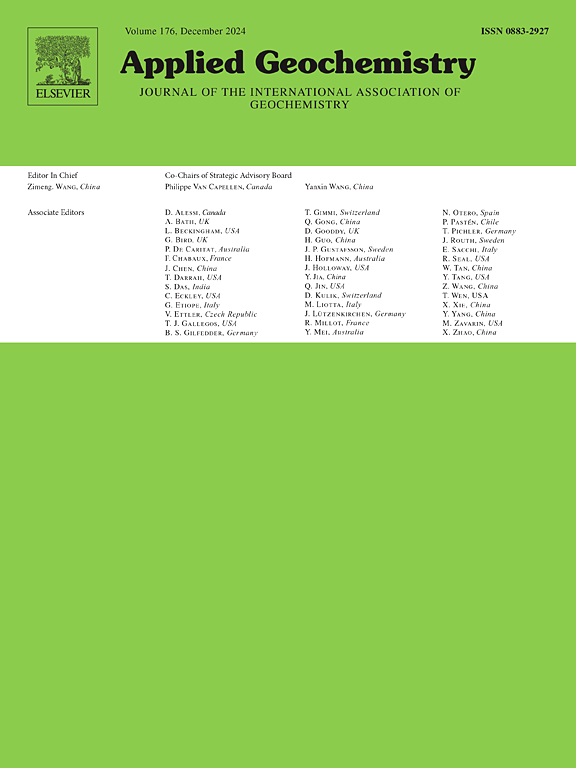Influence of weathering-driven mineralogical evolution on phosphorite dissolution behavior
IF 3.4
3区 地球科学
Q1 GEOCHEMISTRY & GEOPHYSICS
引用次数: 0
Abstract
The phosphorite dissolution and aqueous species release play a pivotal role in the global phosphorus (P) cycle. To elucidate differences in dissolution mechanisms between phosphorite of different weathering degrees, three phosphorite samples (with high, moderate, and low weathering degrees) were collected from field environments; then, a series of mineralogical characterizations coupled with dissolution experiments were conducted. Compared to primary phosphorite, weathered phosphorite exhibited substantial depletion of carbonate minerals, while silicate minerals and phosphate minerals were relatively enriched, and secondary minerals (e.g., FePO4 and CaF2) were formed. Furthermore, the dissolution rates of phosphorite samples within a pH range of 3–7 were determined using a mixed-flow reactor. The results demonstrated a negative linear relationship between the logarithm of dissolution rate and pH (R2 = 0.54–0.94). The P release rate constant (from 0.7 to 1.52 mol g−1 s−1) and kinetic reaction order (from 0.58 to 0.74) of weathered phosphorite were significantly higher than those of primary phosphorite. We modeled the co-dissolution behavior of associated minerals with fluorapatite using transition state theory. Calcite exhibited the strongest inhibitory effect on fluorapatite dissolution, whereas the effects of other minerals were relatively weak. In the column leaching experiment, compared to the primary phosphorite, the elements released from weathered phosphorite were predominantly present in ionic forms with a higher migration capability. During the leaching process, phosphate minerals in phosphorite were mainly converted to Exchangeable/loosely bound P (Ex-P), Iron-bound P (Fe–P), and Calcium-bound P (Ca–P); Ca2+ and CO32− were mainly converted to dolomite, and F− was mainly converted to fluorite and fluorapatite. This systematic investigation provides critical insights into weathering-driven mineralogical evolution and its mechanistic control on phosphorite dissolution.

风化驱动矿物学演化对磷矿溶蚀行为的影响
磷矿溶解和水样释放在全球磷循环中起着关键作用。为了阐明不同风化程度磷矿溶蚀机理的差异,在野外环境中采集了高、中、低风化程度磷矿样品;然后,进行了一系列矿物学表征和溶蚀实验。与原生磷矿相比,风化磷矿中碳酸盐矿物大量枯竭,硅酸盐矿物和磷酸盐矿物相对富集,形成了FePO4、CaF2等次生矿物。此外,在3-7的pH范围内,用混流反应器测定了磷矿样品的溶解速率。结果表明,溶出率的对数与pH呈负线性关系(R2 = 0.54 ~ 0.94)。磷释放速率常数(0.7 ~ 1.52 mol g−1 s−1)和动力学反应阶数(0.58 ~ 0.74)均显著高于原生磷矿。我们用过渡态理论模拟了伴生矿物与氟磷灰石的共溶行为。方解石对氟磷灰石溶解的抑制作用最强,其他矿物的抑制作用相对较弱。在柱浸试验中,与原生磷矿相比,风化磷矿释放的元素主要以离子形式存在,迁移能力更强。在浸出过程中,磷矿石中的磷矿物主要转化为可交换/松散结合磷(Ex-P)、铁结合磷(Fe-P)和钙结合磷(Ca-P);Ca2+和CO32 -主要转化为白云石,F -主要转化为萤石和氟磷灰石。这项系统的研究为风化驱动的矿物学演化及其对磷矿溶解的机制控制提供了重要的见解。
本文章由计算机程序翻译,如有差异,请以英文原文为准。
求助全文
约1分钟内获得全文
求助全文
来源期刊

Applied Geochemistry
地学-地球化学与地球物理
CiteScore
6.10
自引率
8.80%
发文量
272
审稿时长
65 days
期刊介绍:
Applied Geochemistry is an international journal devoted to publication of original research papers, rapid research communications and selected review papers in geochemistry and urban geochemistry which have some practical application to an aspect of human endeavour, such as the preservation of the environment, health, waste disposal and the search for resources. Papers on applications of inorganic, organic and isotope geochemistry and geochemical processes are therefore welcome provided they meet the main criterion. Spatial and temporal monitoring case studies are only of interest to our international readership if they present new ideas of broad application.
Topics covered include: (1) Environmental geochemistry (including natural and anthropogenic aspects, and protection and remediation strategies); (2) Hydrogeochemistry (surface and groundwater); (3) Medical (urban) geochemistry; (4) The search for energy resources (in particular unconventional oil and gas or emerging metal resources); (5) Energy exploitation (in particular geothermal energy and CCS); (6) Upgrading of energy and mineral resources where there is a direct geochemical application; and (7) Waste disposal, including nuclear waste disposal.
 求助内容:
求助内容: 应助结果提醒方式:
应助结果提醒方式:


